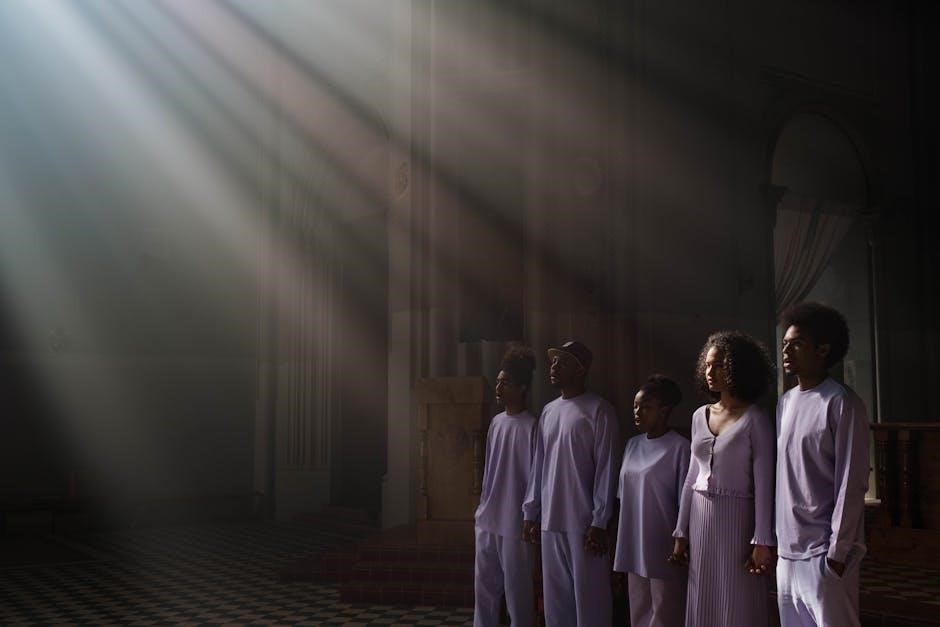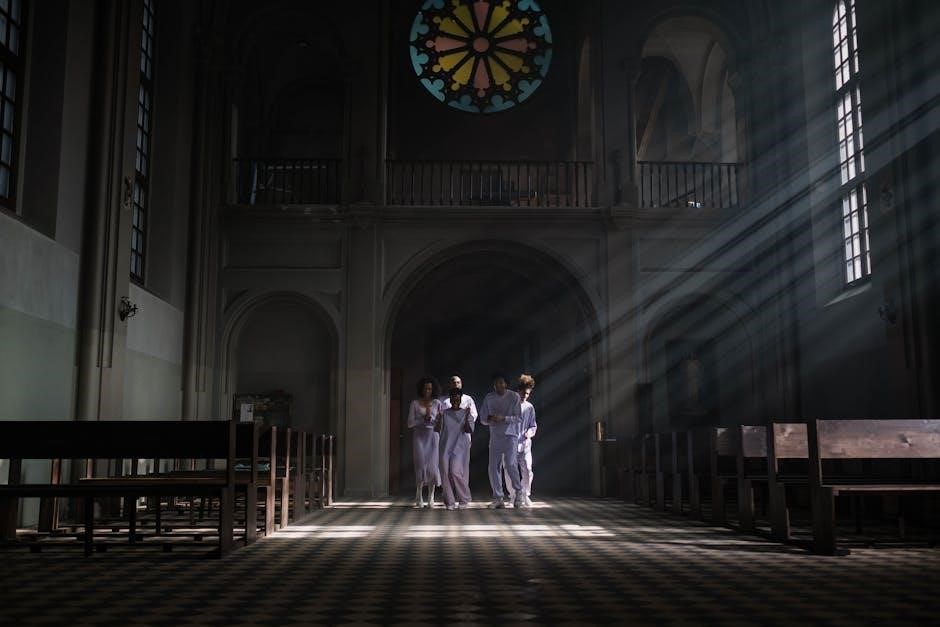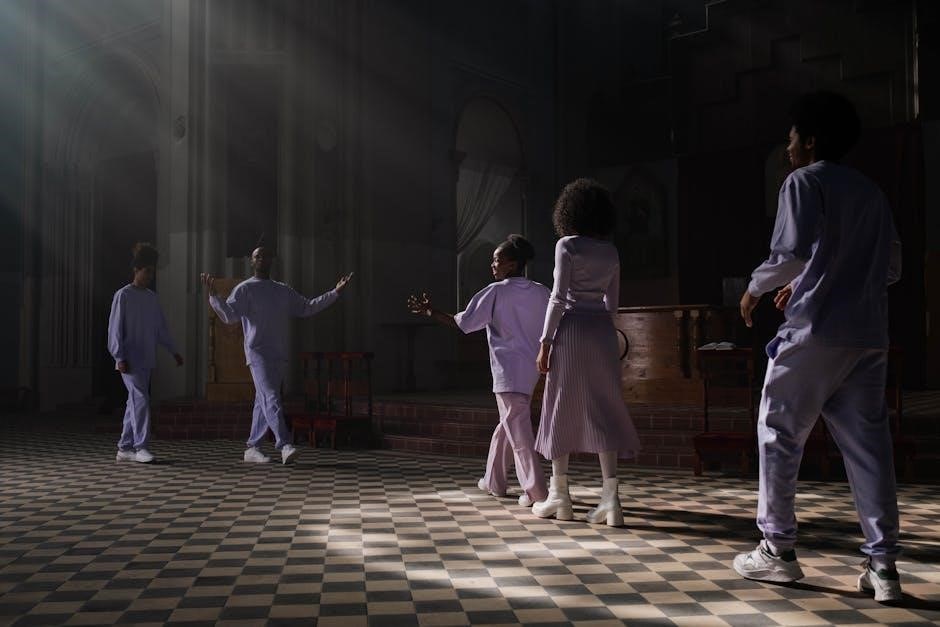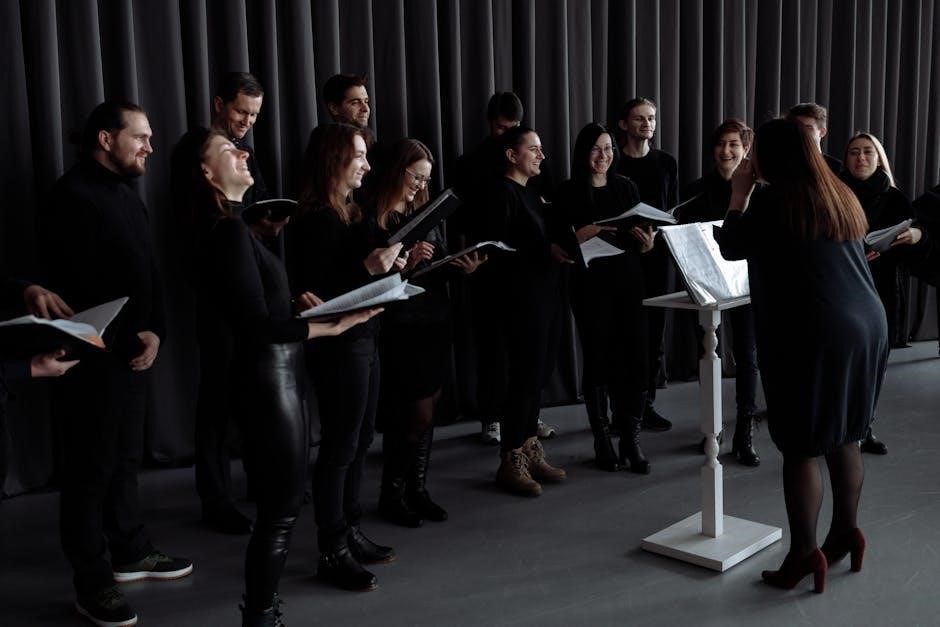The Hallelujah Chorus‚ from Handel’s Messiah‚ is a iconic choral masterpiece. Available as SATB PDF‚ it remains a cornerstone of classical music‚ celebrated for its grandeur and spiritual depth.
1.1 Overview of the Hallelujah Chorus
The Hallelujah Chorus is the iconic final movement of George Frideric Handel’s Messiah‚ an oratorio composed in 1741. Known for its grandeur and emotional depth‚ the piece is a celebration of divine glory‚ featuring the famous “Hallelujah” refrain. Written for a SATB choir and orchestra‚ it showcases intricate harmonies and layered textures‚ making it a cornerstone of classical choral music. Its enduring popularity has led to numerous arrangements‚ including SATB versions‚ which remain central to choral repertoires worldwide.
1.2 Historical Significance of the Piece
The Hallelujah Chorus‚ composed by George Frideric Handel in 1741‚ is the triumphant climax of his oratorio Messiah. It premiered in Dublin to great acclaim for its powerful harmonies and emotional depth. Over centuries‚ it has become a cornerstone of classical music‚ symbolizing joy and celebration. Its historical significance lies in its enduring popularity and influence on choral music‚ with SATB arrangements ensuring its accessibility and timeless appeal‚ cherished by audiences worldwide.
1.3 Importance of SATB Arrangements
SATB arrangements of the Hallelujah Chorus provide a balanced and harmonious choral experience. Each vocal part—Soprano‚ Alto‚ Tenor‚ and Bass—is clearly defined‚ allowing for rich layering and dynamic interplay. This structure ensures accessibility for diverse choirs‚ from amateur to professional. The SATB format preserves Handel’s original intent‚ enabling authentic performances that highlight the piece’s emotional depth and complexity. It remains a cornerstone for choral ensembles‚ fostering unity and artistic expression among singers.

Structure and Composition of the Hallelujah Chorus
The Hallelujah Chorus is a grand climax from Handel’s Messiah‚ featuring intricate vocal and instrumental layers. Its structure includes soaring melodies‚ harmonious choral sections‚ and dramatic orchestral accompaniment‚ creating a vivid tapestry of sound that embodies celebration and reverence.
2.1 Musical Notation and Key Signatures
The Hallelujah Chorus is notated in D major‚ a key often associated with triumph and grandeur. The piece is written in common time‚ with a tempo marking of Allegro moderato. The SATB arrangement features dynamic contrasts‚ from pianissimo to fortissimo‚ and includes intricate articulations such as legato and staccato markings. Vocal ranges are moderate‚ with the soprano reaching a high D6 and the bass descending to a low A2. Instrumental parts‚ including trumpets and timpani‚ are integral to the score.
2.2 Vocal Ranges for SATB Voices
The Hallelujah Chorus SATB arrangement spans moderate vocal ranges‚ ensuring accessibility for most choirs. Sopranos typically sing from A3 to D6‚ with alto parts ranging from F3 to A5. Tenors cover C3 to B4‚ while basses sing from E2 to E4. These ranges allow for balanced harmonies and dramatic expression‚ making the piece suitable for both professional and amateur ensembles; The score often includes dynamic markings to guide vocal intensity and phrasing.
2.3 Instrumental Accompaniment Options
The Hallelujah Chorus SATB arrangement often features orchestral accompaniment‚ including strings‚ brass‚ and timpani‚ to enhance its grandeur. For smaller ensembles‚ piano or organ reductions are common‚ providing harmonic support. Modern adaptations may incorporate contemporary instruments like a brass quintet or string quartet. These options maintain the piece’s dramatic intensity while offering flexibility for diverse performance settings. Dynamics and rhythm are crucial for accompaniment to complement the vocal parts effectively.

Downloading and Printing the Hallelujah Chorus SATB PDF
Access the Hallelujah Chorus SATB PDF through reputable sheet music websites‚ ensuring compatibility with your printing needs. Adjust settings for optimal clarity and format before printing.
3.1 Free Sheet Music Resources
Explore free sheet music resources like IMSLP‚ Musopen‚ and ChoralWiki to download the Hallelujah Chorus SATB PDF. These platforms offer high-quality‚ downloadable scores‚ often with multiple arrangements. Ensure compatibility with your vocal and instrumental needs. Many sites provide free access to public domain works‚ making it easy to find and print the piece. Always verify the arrangement’s suitability for your group before downloading.
3.2 Paid Sheet Music Platforms
For high-quality‚ professional arrangements‚ consider paid platforms like Musicnotes‚ Sheet Music Plus‚ or J.W; Pepper. These sites offer a wide range of SATB scores‚ including the Hallelujah Chorus‚ with precise notation and orchestral accompaniment options. Paid versions often include customization features and guarantees of accuracy. Purchasing ensures legal compliance and access to exclusive editions tailored for choirs and ensembles.
3.3 Tips for Printing and Binding Sheet Music
For optimal results‚ print the Hallelujah Chorus SATB PDF on high-quality paper using a laser printer for crisp notation. Ensure proper margins and scaling to fit standard sheet music sizes. Bind sheets using three-ring binders or spiral binding for durability. Consider using page protectors to prevent wear. Double-check alignment and page order before printing to avoid errors. This ensures a professional and practical format for rehearsals and performances.

Popular Arrangements of the Hallelujah Chorus
The Hallelujah Chorus is available in various arrangements‚ including classical versions by Mozart and Beethoven‚ modern adaptations‚ and gospel interpretations‚ each offering unique musical perspectives.
4.1 Classical Arrangements by Notable Composers
The Hallelujah Chorus has been reimagined by renowned composers such as Mozart and Beethoven‚ who added intricate harmonies and orchestral depth while preserving its iconic melody. These classical arrangements often feature expanded instrumentation‚ enhancing the piece’s grandeur. Available in SATB PDF formats‚ they offer a blend of traditional and interpretive elements‚ appealing to both purists and those seeking fresh perspectives. These versions remain popular among choirs and classical music enthusiasts.
4.2 Modern and Contemporary Interpretations
Modern arrangements of the Hallelujah Chorus often blend traditional SATB harmonies with contemporary styles‚ such as a cappella‚ gospel‚ or electronic music. Artists like Pentatonix and gospel choirs have reimagined the piece‚ infusing it with fresh energy. These interpretations‚ available as SATB PDFs‚ offer creative twists while maintaining the original’s essence. They cater to diverse musical tastes‚ making the chorus accessible to new generations and broadening its cultural impact.
4.3 Gospel and Sacred Music Versions
Gospel and sacred music versions of the Hallelujah Chorus often emphasize spiritual reverence and uplifting harmonies. Many arrangements feature powerful SATB vocals‚ accompanied by organs‚ tambourines‚ or full gospel bands. These versions‚ widely available as SATB PDFs‚ highlight the piece’s religious core while adding soulful‚ emotive expressions. They are popular in churches and sacred performances‚ connecting audiences with the music’s divine inspiration and timeless message of celebration and praise.

Learning and Performing the Hallelujah Chorus
Mastering the Hallelujah Chorus SATB arrangement requires dedication and practice. Rehearse techniques‚ harmonize SATB voices‚ and collaborate with conductors for a polished performance‚ ensuring spiritual resonance.
5.1 Rehearsal Techniques for Choirs
Effective rehearsal techniques for the Hallelujah Chorus SATB involve sectional practices‚ focusing on harmonies and dynamics. Start with slow tempos to ensure accuracy‚ gradually increasing speed. Emphasize proper breathing and pitch control. Use metronomes to maintain rhythm and balance between voices. Highlight key dynamics‚ such as the dramatic crescendos and soft passages. Encourage individual section leaders to guide their groups. Record rehearsals to identify areas for improvement. Consistent practice fosters unity and precision.
5.2 Tips for Individual Vocal Practice
Individual vocal practice for the Hallelujah Chorus SATB requires focused preparation. Start by listening to recordings to familiarize yourself with the piece. Practice vocal warm-ups to improve range and control. Break the chorus into sections‚ mastering each part before combining them. Use a metronome to maintain tempo. Focus on dynamics and articulation‚ especially in key moments like the “Hallelujah” refrain. Record yourself to identify areas for improvement. Prioritize breath control for sustained phrases.
5.3 Conducting and Directing the Piece
Conducting the Hallelujah Chorus requires strong leadership and attention to detail. Ensure clear gestures for tempo and dynamics‚ as the piece transitions between powerful and delicate sections. Emphasize balance between voices and instruments‚ particularly in the SATB arrangement. Highlight key dynamics‚ such as the dramatic shift from pianissimo to fortissimo. Guide the choir in precise articulation and phrasing to maintain clarity. Rehearse thoroughly to unify the ensemble’s interpretation and deliver a cohesive performance. A well-directed piece leaves a lasting impression.

Legal and Copyright Considerations
Understanding copyright laws is crucial when using the Hallelujah Chorus SATB PDF. Ensure proper licensing for performances and distributions to avoid legal issues. Respect intellectual property rights.
6.1 Understanding Copyright Laws for Sheet Music
When accessing the Hallelujah Chorus SATB PDF‚ it’s essential to understand copyright laws. While the original composition by Handel is in the public domain‚ specific arrangements may be copyrighted. Always verify the copyright status of the sheet music. If a version is copyrighted‚ ensure you have permission or a license to use it. Respect the rights of arrangers and publishers to avoid legal issues. This ensures ethical use and supports creators.
6.2 Licensing for Performance and Distribution
Licensing is crucial for legally performing or distributing the Hallelujah Chorus SATB PDF. For public performances‚ obtain a performance license from organizations like ASCAP or BMI. Distribution‚ such as sharing arrangements online‚ may require mechanical licenses. Ensure all rights are cleared‚ especially for copyrighted arrangements. Contact publishers or licensing agencies to secure proper permissions‚ avoiding potential legal issues and supporting creators ethically.
6.4 Using Royalty-Free Arrangements
Royalty-free arrangements of the Hallelujah Chorus SATB PDF are ideal for performers and educators seeking cost-effective solutions. Since Handel’s original work is in the public domain‚ many arrangements are available without licensing fees. Websites like IMSLP or Musopen offer free versions. Ensure the arrangement is explicitly labeled as royalty-free and verify its terms of use. This option is perfect for educational purposes‚ community performances‚ or informal events‚ providing accessibility while respecting copyright norms.

Cultural and Historical Context
The Hallelujah Chorus‚ from Handel’s Messiah‚ is a cornerstone of classical music‚ composed in 1741. Its religious themes and grand orchestration reflect 18th-century musical traditions.
It remains a cultural icon‚ often performed during holidays and celebrations‚ symbolizing joy and spiritual triumph through its powerful harmonies and timeless appeal.
7.1 The Premiere and Reception of Messiah
Handel’s Messiah premiered in Dublin on April 13‚ 1742‚ at the New Music Hall. The performance was a triumph‚ with a large audience in attendance. The Hallelujah Chorus‚ in particular‚ received widespread acclaim‚ marking a pivotal moment in the piece’s recognition. This successful debut‚ featuring a formidable orchestra and choir‚ solidified Messiah’s enduring place in classical music history.
7.2 The Role of the Hallelujah Chorus in Popular Culture
The Hallelujah Chorus has transcended classical music‚ becoming a cultural icon. It appears in films‚ TV shows‚ and commercials‚ often symbolizing triumph or celebration. Politicians and athletes have used it to evoke grandeur‚ and it’s a staple at weddings and ceremonies. Its uplifting melody and universal appeal make it a favorite for diverse audiences‚ ensuring its relevance beyond traditional classical settings.
7.3 The Piece’s Enduring Legacy
Composed by George Frideric Handel in 1741‚ the Hallelujah Chorus remains a cornerstone of classical music. Its timeless appeal lies in its triumphant harmonies and spiritual depth. Over centuries‚ it has inspired countless performances‚ arrangements‚ and adaptations. The piece’s ability to evoke emotion and unity ensures its lasting impact. Its inclusion in SATB arrangements has further cemented its accessibility and popularity‚ making it a beloved choice for choirs worldwide.

Resources for Further Study
Explore the Hallelujah Chorus further with recommended sheet music websites‚ books on Handel’s Messiah‚ and online courses offering in-depth analysis and performance guides.
8.1 Recommended Sheet Music Websites
Discover high-quality SATB arrangements of the Hallelujah Chorus on websites like Musicnotes‚ Sheet Music Plus‚ and ChoralSheetMusic. These platforms offer downloadable PDFs with accurate notation and vocal parts. Many sites provide previews‚ ensuring compatibility with your choir’s needs. Some also feature instrumental accompaniment scores. Use filters to find arrangements tailored to SATB ensembles‚ and check for free or royalty-free options to suit your budget and performance requirements.
8.2 Books on Handel and the Messiah
Explore the life of George Frideric Handel and the creation of Messiah through books like “Handel’s Messiah: A Celebration” by Watkins Shaw and “The Cambridge Handel Encyclopedia”. These resources provide rich insights into Handel’s compositional style‚ the historical context of Messiah‚ and its enduring influence. They are essential for musicians and enthusiasts seeking a deeper understanding of the Hallelujah Chorus and its place in musical history.
8.3 Online Courses and Tutorials
Enhance your understanding of the Hallelujah Chorus through online courses and tutorials. Platforms like Coursera‚ Udemy‚ and Skillshare offer classes on choral music and Handel’s works. YouTube tutorials provide step-by-step guides for vocalists and conductors. These resources cover SATB arrangements‚ historical context‚ and performance techniques‚ helping musicians refine their skills and appreciation for the piece. They are ideal for both beginners and experienced performers seeking to deepen their connection with Handel’s masterpiece.

Community and Collaboration

Engage with global communities through choir groups‚ forums‚ and collaborative projects. Share insights‚ arrangements‚ and performances to foster creativity and unity among music enthusiasts worldwide.
9;1 Joining Choirs and Musical Groups
Joining choirs or musical groups offers a supportive environment to practice and perform the Hallelujah Chorus SATB. Collaborating with others enhances your understanding and appreciation of the piece. Many choirs provide access to sheet music‚ expert guidance‚ and performance opportunities. Engaging with fellow musicians fosters camaraderie and improves your vocal technique. Look for local or online groups to connect with like-minded individuals and elevate your musical experience.
9.2 Sharing and Collaborating on Arrangements
Sharing and collaborating on Hallelujah Chorus SATB arrangements fosters creativity and innovation. Online platforms allow musicians to upload‚ download‚ and modify scores‚ encouraging communal refinement. Collaborators can exchange ideas‚ refine harmonies‚ and adapt the piece to suit diverse styles. This collective approach not only enriches the musical experience but also ensures the piece remains vibrant and accessible to new generations of performers and audiences worldwide.
9.3 Participating in Online Forums and Discussions
Engaging in online forums and discussions about the Hallelujah Chorus SATB PDF can enhance your musical journey. These platforms offer valuable insights‚ tips‚ and feedback from experienced musicians. You can troubleshoot challenges‚ share interpretations‚ and learn from others’ experiences. Active participation fosters a sense of community and helps refine your skills. Popular forums like Reddit or specialized music groups provide spaces for meaningful exchanges‚ ensuring you stay connected and inspired within the musical community.
The Hallelujah Chorus SATB PDF remains a timeless masterpiece‚ offering rich opportunities for musical exploration and performance. Embrace its beauty and share its joy with others.
10.1 Final Thoughts on the Hallelujah Chorus
The Hallelujah Chorus SATB PDF is a timeless masterpiece‚ offering unparalleled richness in its harmonies and spiritual depth. Its SATB arrangement ensures versatility for ensembles of all sizes. As a cornerstone of choral repertoire‚ it continues to inspire performances worldwide. Whether for worship‚ concert halls‚ or personal practice‚ this piece remains a powerful expression of faith and musical brilliance‚ connecting generations through its enduring beauty and emotional resonance.
10.2 Encouragement to Explore and Perform
Embrace the Hallelujah Chorus SATB PDF as a gateway to musical and spiritual enrichment. Its timeless beauty and universal appeal make it accessible to singers of all levels. Exploring its intricate harmonies and powerful dynamics offers a rewarding experience. Performing it fosters unity among choir members and connects audiences to its profound message; Dive into this iconic piece‚ and let its majesty inspire your musical journey and share its joy with the world.